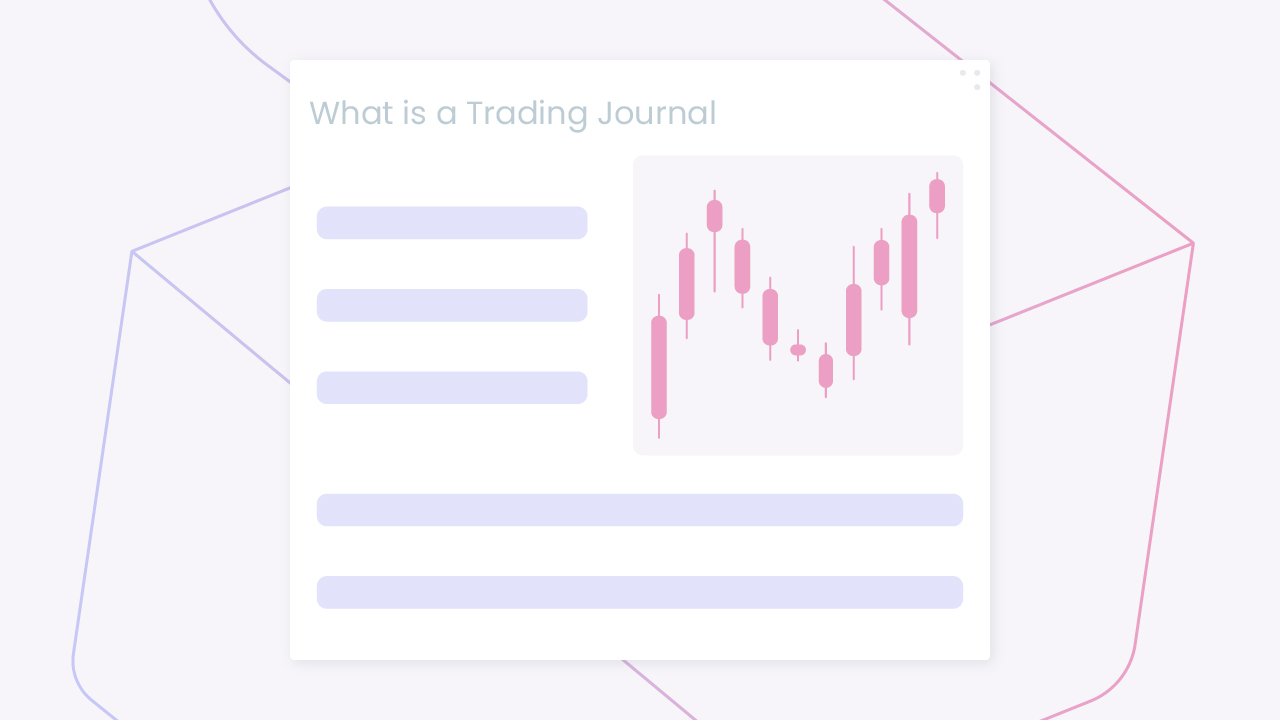What Is a Trading Journal?
A trading journal is a personal record where traders log each of their trades along with relevant details like strategy used, entry/exit points, outcome, and psychological state. It can be maintained digitally or on paper, and it plays a crucial role in evaluating performance, improving discipline, and spotting emotional or strategic patterns over time.
It is more than just a log of your trades, it is a comprehensive trading journal that encompasses insights into your decision-making processes, emotional states during trades, and detailed analysis of outcomes. This documentation serves as a personalised performance database that enables traders to identify patterns, refine strategies, and develop greater trading discipline over time.
The Importance of a Trading Journal for Traders
Success in forex trading doesn’t come from luck — it comes from discipline, reflection, and continuous improvement. A trading journal is the foundation of that process. It transforms your daily trades into valuable insights that can dramatically enhance your performance, emotional control, and strategy development. Platforms like FXNotes.com make this process effortless, providing you with a structured and intelligent way to track your trades, analyse your decisions, and grow as a trader.
1. Performance Evaluation
Your trading journal is your personal performance tracker — a mirror that reflects your true trading habits. By documenting each trade’s details, including entry and exit points, trade size, and reasoning, you can uncover patterns that reveal what’s driving your success or losses. Over time, these records help you distinguish between strategy-based wins and those driven by market luck. With FXNotes, you can generate analytics that show your win rate, risk-to-reward ratios, and performance across different currency pairs. This data-driven feedback allows you to refine your strategies and focus on the setups that consistently deliver results.
2. Emotional Discipline
Trading psychology plays a crucial role in achieving consistent profitability. Emotions such as fear, greed, and frustration often lead traders to make impulsive or irrational decisions. A trading journal allows you to record your emotional state during each trade, giving you visibility into how emotions influence your choices. For example, you may notice that fear of missing out (FOMO) causes you to enter trades too early or that overconfidence leads to oversized positions. Recognising these patterns is the first step toward mastering emotional discipline. FXNotes.com lets you tag emotional states and review them alongside your results — helping you cultivate patience, confidence, and control.
3. Strategy Development
Every successful trader evolves through experimentation, backtesting, and refinement. A trading journal is the perfect environment for this evolution. By reviewing historical trades, you can identify which setups, indicators, and timeframes produce the best outcomes for your trading style. Whether you trade price action, use technical indicators, or rely on automated systems, your journal becomes a testing ground for optimisation. With FXNotes, you can easily filter trades by strategy, compare outcomes, and visualise performance trends — allowing you to fine-tune your trading plan for greater consistency and profitability.
4. Risk Management
Effective risk management separates professional traders from gamblers. Keeping a detailed record of your trades helps you understand how well you’re managing risk per trade, your position sizing discipline, and your adherence to stop-loss rules. A journal helps expose moments where you took on excessive risk or ignored your trading plan. By analysing these instances, you can make precise adjustments that protect your capital and improve long-term sustainability. FXNotes automates this process, showing you metrics like average drawdown, risk exposure, and maximum consecutive losses — key indicators that guide better decision-making.
5. Learning from Mistakes
Every mistake in forex trading is an opportunity to grow — but only if you capture and learn from it. A trading journal preserves a complete record of your decisions, including those that didn’t go as planned. Reviewing losing trades helps you identify the underlying causes, whether it’s a flawed analysis, poor timing, or emotional bias. This continuous learning loop accelerates your development as a trader. With FXNotes.com, your journal becomes an interactive learning tool where mistakes transform into insights and experience becomes your most valuable asset.
Start Journaling Smarter with FXNotes
In a market as dynamic as forex, knowledge and self-awareness are your most powerful tools. FXNotes.com empowers traders to go beyond basic note-taking by offering smart analytics, emotional tagging, and intuitive performance tracking — all designed to help you trade smarter, not harder. Start using FXNotes today and turn every trade into a step toward mastery.
Common Mistakes Without a Journal
- Forgetting why you entered a trade
- Failing to learn from repeat losses
- Allowing emotion to override your plan
- Making random decisions with no data trail
Formats: Digital vs. Pen-and-Paper
Traditional (Pen & Paper):
Pros: Simple, tactile, good for emotional reflection
Cons: No analytics, harder to search or sort
Digital (Software, Excel, Notion):
Pros: Searchable, analysable, often includes charts, auto-imports
Cons: Can be complex or require subscriptions
Pro Tip: Beginners often start with a notebook or spreadsheet, then graduate to digital tools like TraderVue or Edgewonk as their needs grow.
Example Entry Template
| Field | Example |
| Date | June 25, 2025 |
| Pair | EUR/USD |
| Direction | Long |
| Entry/Exit | 1.0735 → 1.0780 |
| Strategy | Breakout |
| Result | 45 pips |
| Emotions | Hesitated entry after 2 losses |
| Lesson Learned | Need to trust setup during volatility |
The Six Essential Components Every Trading Journal Must Include
Comprehensive trading journals must document six critical elements: trade details, date and time, entry and exit points, position size, risk management parameters, and emotional context. Each component serves a specific purpose in creating a complete picture of your trading activities.
1. Trade Details
Every journal entry should specify the financial instrument traded, market conditions at the time, and the reasoning behind the trade selection. This includes currency pairs for forex trading, stock symbols for equity trades, or commodity specifications for futures trading.
2. Precise Timing Documentation
Recording exact dates and times of trade execution is crucial for assessing market volatility patterns and identifying optimal trading windows. This temporal data helps traders recognise when they perform best and adjust their trading schedules accordingly.
3. Entry And Exit Information
Documenting exact entry and exit points enables assessment of timing effectiveness and decision-making processes. This information reveals whether traders are consistently entering trades at optimal levels or if there are systematic improvements needed in execution timing.
4. Position Size Tracking
Position size documentation is critical for managing risk and determining trade profitability potential. Tracking position sizes relative to account size helps ensure proper risk management and identifies whether position sizing aligns with overall trading strategy.
5. Risk Management Strategies
Documenting risk management approaches for each trade, including stop-loss and take-profit placement, enables evaluation of risk management effectiveness over time. This component is essential for maintaining consistent risk parameters and improving capital preservation strategies.
6. Emotional And Contextual Information
Recording thoughts, feelings, and market context during trade execution provides insights into psychological factors affecting performance. Emotional documentation helps identify patterns between mental state and trading outcomes, leading to improved emotional discipline.
How Does FXNotes Make Forex Journaling Smarter?
FXNotes.com enhances traditional journaling with automated trade imports, AI-driven analytics, and emotional tagging. Its smart dashboard visualises performance metrics and behavioural trends, helping traders make data-backed decisions faster.
Main features include:
- Automatic trade tracking from MT4, MT5, or cTrader.
- Emotional and strategic tagging for deeper analysis.
- Profitability insights by instrument, time, and method.
- Personalised performance reports to guide improvements.
How to Start a Forex Trading Journal with FXNotes
Starting is simple. Connect your trading account to FXNotes, categorise your trades, and record emotions and insights after each session. Within weeks, you’ll identify clear patterns that drive better results and emotional consistency. Consistent journaling turns short-term volatility into long-term strategy development.
Steps to begin journaling:
- Log all trades with key data (entry, exit, reasoning).
- Note emotions and market context during trades.
- Review results weekly for trend and error analysis.
- Adjust your strategy based on verified data insights.



